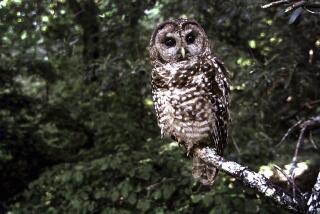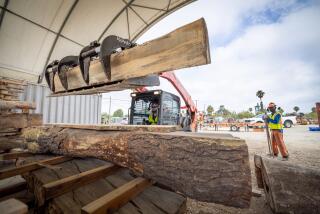Closing of Its Timber Mill Drives a Stake Into the Heart of Hayfork : Industry: Residents fear that it may become a ghost town. Recession and technological advances forced the shutdown, but some blame the efforts to protect the spotted owl.
- Share via
HAYFORK, Calif. — Dec. 13 was a gloomy day in Hayfork. Sierra Pacific Industries closed its timber mill, throwing 150 people out of work.
The mill represented half of Hayfork’s total salary base. And virtually every other business in the town of 2,500, from video stores to animal hospitals, depends on the mill for paying customers.
Now resentful residents in this remote town face a fearful future, as they scour the rugged mountains for jobs.
“You can feel the tension here. You can see it,” said Charles Sanborn, a Trinity County sheriff’s sergeant and Hayfork’s unofficial police chief. “You know something’s different now. I can tell you, I’m not looking forward to the winter.”
Hayfork is one of several small towns whose future has been made uncertain by changes in the Northwest timber industry. The timber companies are facing slack demand for their goods because of the recession-plagued building slump. Technological improvements have reduced the need for many workers.
Meanwhile, the companies are getting squeezed by government regulations to protect the northern spotted owl. The Fish and Wildlife Service has proposed designating more than 8 million acres of national forest--an area larger than Maryland--as critical habitat for the threatened bird, banning logging on most of those acres and restricting it on the rest.
The timber cutback could be devastating for places such as Hayfork and the rest of Trinity County. With 30,000 people and no incorporated cities within its boundaries, the county fears that the industry’s collapse will turn this rugged region 250 miles north of San Francisco into a Californian Appalachia.
“That was the only industry here, period,” said Nadine Bailey, a logging contractor whose business has a dozen employees. “Last year, our payroll was $280,000; this year it was $20,000. My husband now lives elsewhere to work, and commutes here once a week.”
Sierra Pacific, based in Arcata, had run the mill in Hayfork for about 30 years before shutting it down last month. It was the first mill the company closed in 35 years.
But it was the last of half a dozen mills in the area to be shut down, victims of industry changes. The mill was handling only 30 million board-feet of timber a year, less than half the amount needed to sustain it.
Hayfork residents are certain that the mill was forced to close because of the spotted owl. The U.S. Forest Service has been forced to halt new timber sales from its lands until it develops an owl protection plan acceptable to a federal court. The process is expected to take months.
“This could mean you’re going to have whole communities disappear. You’re going to have whole rural counties go bankrupt because their industry is being taken away,” Bailey said.
Alice Ackerly, who owns Alice’s Restaurant and heads a local economic development group, agreed.
“It’s a little bird that in essence may shut down the whole town. This is a war and we’re right in the middle of a war,” she said.
Environmentalists contend that the mill was a victim of the recession, declining demand and poor management.
Since World War II, more than 900 timber mills have closed in California, and fewer than 100 remain. Within the past year, mills have closed or were slated for shutdown in several Northern California towns, including Montague, McCloud and Happy Camp.
“The spotted owl gets blamed for practically every job that’s lost in the timber industry, and other factors like the recession, the modernization of the timber industry, the historic overcutting on private and public lands, somehow never get brought up. So the image of the owl being a scapegoat to cover all of these industry ills is one we see very commonly used,” said Dan Taylor, an Audubon Society spokesman.
Ackerly and others find Taylor’s analysis hard to accept.
“Timber people here have been doing the same thing for generations,” she said. “And it’s hard to tell them: ‘Don’t follow in your father’s footsteps.’ ”
Either way, people in Hayfork face big decisions about their future. Some have thought about new industry in town, and a few have made a pitch for an industrial park. But they could not generate much interest. Hayfork is 50 miles from the nearest interstate and more than 250 miles from San Francisco, making it hard to get business to locate here.
So many are looking for jobs outside the region. Some have found work 200 miles away and commute home on the weekends, such as Bailey’s husband.
“Lots of people here are in the same situation,” she said. “They feel desperate. They don’t really have any hope that things will get better. They are thinking this could become a ghost town.”
ANOTHER CASUALTY: Oregon logging town seeks new ways to survive. B5
Top Lumber Producers
Here are the top five lumber producers in 1990, according to Forest Industries Magazine. The name of the company is followed by lumber production in 1990 and lumber production in 1989:
1. Weyerhaeuser, 2.9 billion board feet in 1990. 2.97 billion board feet in 1989.
2. Georgia-Pacific, 2.5 billion board feet, 2.4 billion board feet.
3. Louisiana-Pacific, 2.2 billion board feet, 2.4 billion board feet.
4. WTD Industries, 995.8 million board feet, 1.2 billion board feet.
5. Sierra Pacific, 967 million board feet, 950 million board feet.
Source: Associated Press
More to Read
Inside the business of entertainment
The Wide Shot brings you news, analysis and insights on everything from streaming wars to production — and what it all means for the future.
You may occasionally receive promotional content from the Los Angeles Times.










